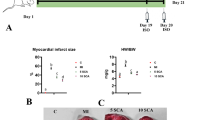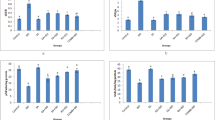Cardiovascular diseases are the most disturbing problem throughout the world. The side effects of existing drugs are continuously compelling scientists to look for some better options in terms of safety, efficacy and cost-effectiveness. Moving in this direction, we used cinnamaldehyde and quercetin combination to see its cardioprotective effect in isoproterenol-induced myocardial infarction in Wistar rats. Experimental animals were randomly divided into six groups: (I) normal saline (0.1 mL/kg, p.o.) treated group; (II) isoproterenol (ISO, 85 mg/kg, s.c.) treated group; (III—V) cinnamaldehyde (90 mg/kg/day, p.o.), quercetin (50 mg/kg/day, p.o.) and their combination [cinnamaldehyde (45 mg/kg/day, p.o) + quercetin (25 mg/kg/day, p.o.)] treated groups, respectively; (VI) per se group of the combination. Drugs were administered as a single daily dose for 15 days, with isoproterenol on 14th and 15th day of experiment. Animals were sacrificed 24 h after the last dosing, and various parameters were estimated. Subcutaneous administration of ISO in rats caused increase in cardiac malondialdehyde (MDA), CK-MB and LDH concentration as well as decreased glutathione (GSH), total antioxidant capacity (TAC) and catalase content. ISO administration further increased the expression of NF-kB and cleaved caspase 3. The level of these parameters was significantly reversed toward normal. The treatment with cinnamaldehyde + ISO and quercetin + ISO reduced the infarct size (p < 0.001), whereas cinnamaldehyde + quercetin + ISO exhibited better reduction in infarcted area (P > 0.001) than the treatment with cinnamaldehyde and quercetin individually and in combination. Thus, cinnamaldehyde and quercetin taken individually showed cardioprotection, but a combination of half their doses gave better results.






Similar content being viewed by others
References
N. L. Fitriyani, M. Syafrudin, G. Alfian, and J. Rhee, IEEE Access, 8, 133034 – 133050 (2020).
S. Boudina, M. N. Laclau, L. Tariosse, et al., Am. J. Physiol.: Heart Circ. Physiol., 282(3), H821 - H831 (2002).
S. Takeo, G. Taam, R. Beamish, and N. S. Dhalla, J. Pharmacol. Exp. Ther., 214(3), 688 – 693 (1980).
A. Bindoli, M. P. Rigobello, and D. J. Deeble, Free Radical Biol. Med., 13(4), 391 – 405 (1992).
N. S. Dhalla, R. M. Temsah, and T. Netticadan, J. Hypertens., 18(6), 655 – 673 (2000).
J. H. Doroshow, Cancer Res., 43(2), 460 – 472 (1983).
J. C. Liao, J. S. Deng, C. S. Chiu, et al., J. Evidence-Based Complementary Altern. Med. (2012).
A. J. Smith, P. Kavuru, L. Wojtas, et al., Mol. Pharmaceutics, 8(5), 1867 – 1876 (2011).
H. B. Jin, Y. B. Yang, Y. L. Song, et al., Mol. Biol. Rep., 39(12), 11005 – 11009 (2012).
L. L.Wan, J. Xia, D. Ye, et al., Cardiovasc. Ther., 27(1), 28 – 33 (2009).
W. Krol, Z. Czuba, S. Scheller, et al., Biochem. Int., 21(4), 593 – 597 (1990).
J. M. Chow, S. C. Shen, S. K. Huan, et al., Biochem. Pharmacol., 69(12), 1839 – 1851 (2005).
X. Xiao, D. Shi, L. Liu, et al., PLoS One, 6(8), e22934 (2011).
C. A. Warren, K. J. Paulhill, L. A. Davidson, et al., J. Nutr., 139(1), 101 – 105 (2008).
D. Koracevic, G. Koracevic, V. Djordjevic, et al., J. Clin. Pathol., 54(5), 356 – 361 (2001).
S. H. Tsung, Clin. Chem., 29(12), 2040 – 2043 (1983).
G. Lum and S. R. Gambino, Am. J. Clin. Pathol., 61(1), 108 – 113 (1974).
H. Ohkawa, N. Ohishi, and K. Yagi, Anal. Biochem., 95(2), 351 – 358 (1979).
O. H. Lowry, J. Biol. Chem., 193, 265 – 275 (1951).
J. Sedlak and R. H. Lindsay, Anal. Biochem., 25(1), 192 – 205 (1968).
G. L. Ellman, Arch. Biochem. Biophys., 82(1), 70 – 77 (1959).
J. Takagawa, Y. Zhang, M. L. Wong, et al., J. Appl. Physiol., 102(6), 2104 – 2111 (2007).
C. Nirmala and R. Puvanakrishnan, Mol. Cell. Biochem., 159(2), 85 – 93 (1996).
P. S. Tappia, T. Hata, L. Hozaima, et al., Arch. Biochem. Biophys., (1), 85 – 92 (2001).
N. S. Dhalla, A. B. Elmoselhi, T. Hata, and N. Makino, Cardiovasc. Res., 47(3), 446 – 456 (2000).
S. Suchalatha and C. S. Devi, Indian. J. Exp. Biol., 42(2), 174 – 178 (2004).
V. S. Panda and S. R. Naik, Exp. Toxicol. Pathol., 60(4 – 5), 397 – 404 (2008).
G. X. Zhang, S. Kimura, A. Nishiyama, et al., Cardiovasc. res., 65(1), 230 – 238 (2005).
C. Caglayan, F. M. Kandemir, E. Darendelioðlu, et al., J. Trace Elem. Med. Biol., 56, 60 – 68 (2019).
A. Iqubal, M. K. Iqubal, S. Sharma, et al., Life Sci., 218, 112 – 131 (2019).
C. Caglayan, Y. Temel, F. M. Kandemir, et al., Environ. Sci. Pollut. Res., 25(21), 20968 – 20984 (2018).
ACKNOWLEDGMENTS
The athors are thankful to Jamia Hamdard for providing facilities necessary to perform the experimental work.
CONFLICT OF INTEREST
The authors declare that they have no conflicts of interest.
Funding
This research did not receive any specific grants from funding agencies in the public, commercial, or not-for-profit sectors.
Author information
Authors and Affiliations
Corresponding author
Rights and permissions
About this article
Cite this article
Khan, A., Iqubal, A. & Haque, S.E. Combinatorial Delivery of Cinnamaldehyde and Quercetin Ameliorates Isoproterenol-Induced Cardiac Inflammation, Apoptosis and Myocardial Infarction via Modulation of NF-kB P65 and Cleaved Caspase-3 Signaling Molecules in Wistar Rats. Pharm Chem J 56, 197–205 (2022). https://doi.org/10.1007/s11094-022-02621-2
Received:
Published:
Issue Date:
DOI: https://doi.org/10.1007/s11094-022-02621-2




